Recent General Posts
What the Polar Vortex Means for Your Pipes
1/15/2024 (Permalink)
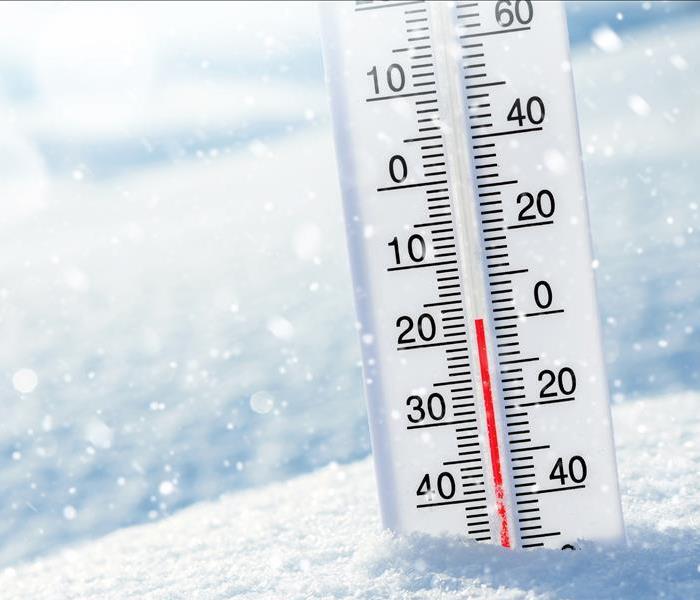 Polar Vortexes bring exceedingly cold temperatures
Polar Vortexes bring exceedingly cold temperatures
As the winter weather continues, "Polar Vortexes" become far more likely, signaling plummeting temperatures and severe weather conditions. This meteorological term, often associated with bone-chilling cold, can have a profound impact on daily life, particularly for homeowners and business owners. In addition to several drops in temperature to worry about, polar vortexes also heavily affect plumbing systems. As temperatures dive, the risk of pipes freezing and subsequently bursting increases, potentially leading to severely damaging water floods. Understanding the polar vortex, how it affects plumbing piping, and the necessary preventive measures are essential for bracing for the winter months. SERVPRO of Parsippany and Montville has crafted some preventive measures you can utilize to ensure your plumbing stays safe during the ongoing polar vortex.
Understanding the Polar Vortex and Its Impact
A polar vortex is essentially a vast expanse of swirling cold air that typically envelopes the polar regions. However, during the winter, the vortex at the North Pole often expands, pushing frigid air toward the equator and affecting much of the Northern Hemisphere. This shift can result in a sudden and steep drop in temperatures, often catching businesses and residences off-guard.
The critical issue with these plummeting temperatures is their effect on water pipes. Water expands when it freezes, and this expansion can exert extraordinary pressure on pipes, regardless of whether they are made of metal or plastic. When the pressure becomes too great, pipes can burst, leading to water damage, the potential for mold growth, and the need for repairs on top of restoration and cleaning services.
Prevention and Protection
To mitigate the risks of a polar vortex freezing your pipes, consider the following preventive steps:
- Insulate Pipes: Wrapping exposed pipes in foam insulation, particularly those in unheated areas like basements, attics, and garages, can significantly reduce the risk of freezing.
- Maintain Consistent Indoor Temperature: Keeping your home heated consistently, even when you're away, helps keep the internal temperature of pipes above freezing.
- Allow Faucets to Drip: Allowing a slight drip in faucets can prevent pressure buildup within pipes, reducing the risk of freezing and bursting.
- Drain Water from Pools and Sprinklers: Drain water from the swimming pool and sprinkler supply lines following the manufacturer's instructions.
- Close Inside Valves Supplying Outdoor Hose Bibs: After removing and draining outdoor hoses, close the inside valves that supply these bibs but leave the outside valve open.
- Insulate Vulnerable Spaces: Increase insulation in areas like attics, basements, and crawl spaces to maintain higher temperatures.
- Open Cabinet Doors: Allow warmer air to circulate around plumbing by opening kitchen and bathroom cabinet doors.
The polar vortex, while a natural weather phenomenon, poses a significant challenge to plumbing, particularly regarding the risk of frozen and bursting pipes. By understanding this meteorological event and taking proactive, preventative measures, you can safeguard your home against the potentially devastating and costly consequences. Prevention actions are far more effective and less costly than repair. Stay warm, stay informed, and prepare your home for whatever the winter brings.
Should you incur any water or storm damage during the Polar Vortex, feel free to contact SERVPRO of Parsippany and Montville, and we'll make it "Like It Never Even Happened!"
Common Misconceptions about Mitigation and Restoration
9/26/2019 (Permalink)
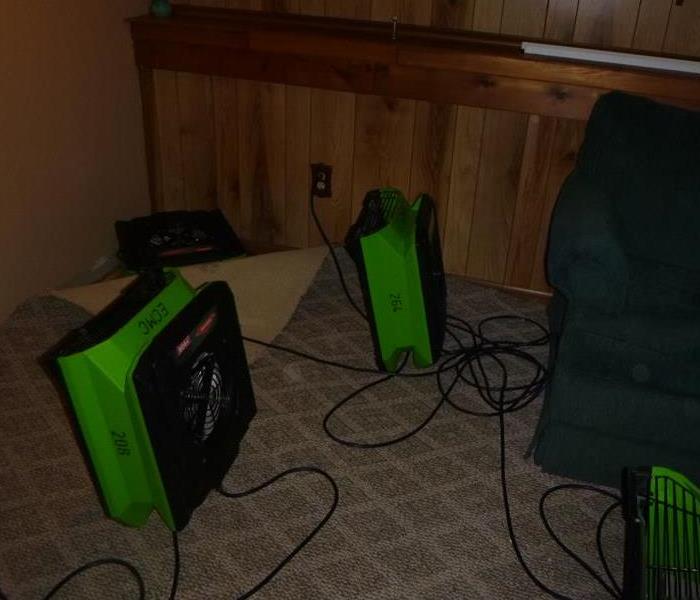 An example of carpet being saved by being lifted for drying.
An example of carpet being saved by being lifted for drying.
There are many misconceptions regarding the mitigation and restoration of property damage. However, our technicians are trained to see beyond the misconceptions and misinformation that often complicate a claim. They will apply the right course of action to mitigate the damages. If someone doesn’t act quickly enough or doesn’t take the right actions due to these misconceptions, they can end up with even more damage to deal with, that could have easily been avoided.
A professional restoration technician will prioritize mitigation over restoration ensuring damage costs do not escalate. Mitigation is extremely time-critical, as it stops further damage and reduces additional loss. It usually needs to be performed within 24 hours or less. Any delay will further complicate or devalue the mitigation effort. Restoration, on the other hand, puts the damaged items back to a preloss condition. It is less time-critical, but still important and should be done as quickly as possible.
Here are the more common misconceptions and the truth behind them:
- Replacing costs less than restoring/salvaging. In most cases, cleaning and salvaging the contents and structure is less expensive than replacing them. This can vary with the circumstances. For instance, if after a fire, smoke soot hasn’t been properly cleaned from all surfaces, replacement may be the only option. Hundreds of dollars of cleaning can become thousands of dollars of replacement due to delayed action. Today’s restoration professionals are able to effectively clean and remove contaminates, saving expensive replacement costs.
- If you clean your carpets, they’ll get dirty more quickly. Techniques, equipment, and materials used in the past to clean carpets were inferior to those used by today’s professionals. In the past, inefficient carpet shampooing left a soap residue that attracted soil more rapidly than prior to cleaning. Restoration professionals now use a cleaning process that both flushes and rinses carpets, and prevents that from happening.
- Drying a home is complete when the carpets are dry. The greatest failure in restoring water-damaged structures is to remove the drying equipment before the drying is complete. Using the carpet or cushion to determine dryness is a poor misrepresentation of whether the structure is dry or not (and one that is not easily defended if litigation follows). Carpet and cushions dry quicker than other structural materials and are not an accurate gauge. The danger with ineffective drying is that it can turn a small loss from water damage into a multi-thousand dollar mold claim. Professional restoration firms use measuring equipment (moisture meters/sensors) to determine if moisture content has been returned to normal standards. Meters and sensors are used to document and record the data that justifies the use of the equipment and the best time to remove it. That is extremely important to accomplish the end result – a totally dry structure.
- A home that has been damaged by fire will always smell like smoke, so cleaning it fast is unnecessary. If you don’t clean the smoke residue immediately after a fire, the valuables in your home may suffer irreversible damage, due to the acidic nature of the smoke particles. Prompt cleaning actions can reduce losses if this acid is removed or neutralized. Odor removal is more complicated than turning on one machine and hoping to achieve satisfactory results. Restoration for smoke odor has to be thorough. All contaminated areas need to be cleaned, deodorized, and sealed where applicable. It is important that all odor molecules are neutralized, either airborne or absorbed.
- It’s cheaper to do it yourself rather than hire a restoration company. This holds true in some cases, but you must be extremely careful, since a botched repair can cost you more in the long run.
Professional restoration firms are the best assurance when it comes to mitigation and restoration. Due to their continuous technical training, they do not repeat the erroneous theories and mistakes of the past. Using the latest equipment and techniques, they make sure that the job is done correctly and completely – the first time.
Make sure to call SERVPRO of East Central Morris County at 973-887-9100 so that we can make it "Like it never even happened."
Pack Out Services for Restoration of your Home or Business
9/18/2019 (Permalink)
When you’re faced with restoring structural damage from fire, water, or mold, it’s vital to protect the contents of your home or business. If they haven’t already been damaged, contents may be ruined during the remediation process. While some content restoration can take place on-site, other items are too delicate, valuable, or heavily damaged to be restored there. In some cases, the building may also be too heavily damaged to allow on-site restoration. Pack-out services take the worry out of protecting your belongings in the aftermath of a disaster and let you deal with other pressing matters.
SERVPRO of East Central Morris County will work with your Insurance Carrier and carefully sort items into two categories: salvageable and unsalvageable. Having professionals make these decisions is better than doing it yourself because we’re more familiar with current restoration methods and technology. An heirloom that you might think is gone forever could be saved with products that are available only to companies in the restoration industry.
After sorting the items, our technicians create a detailed inventory of what can be saved and what is unsalvageable. All damage is thoroughly documented for you and your insurance company to review. This inventory also keeps track of what we have and can be used as a checklist when items are returned later. Ruined items are stored for inspection by the insurance company.
Items that are salvageable are transported to our secure facility for thorough content restoration cleaning using commercially available products and equipment. The items are then stored at the facility until you are ready to receive them again. The company will deliver them to you, either at your restored building or a new location.
If you’ve experienced a water, mold or fire at your home, it’s imperative to have the contents cleaned and restored as soon as possible before they’re unsalvageable. SERVPRO of East Central Morris County provides comprehensive content cleaning on-site (when possible) and pack-out services if the site isn’t secure. We transport your property to our secure facility for restoration and storage and we’ll deliver them back once you’re ready.
SERVPRO of East Central Morris County is here for you, (973) 887-9100.
Leave the Board ups to the PROs
4/30/2019 (Permalink)
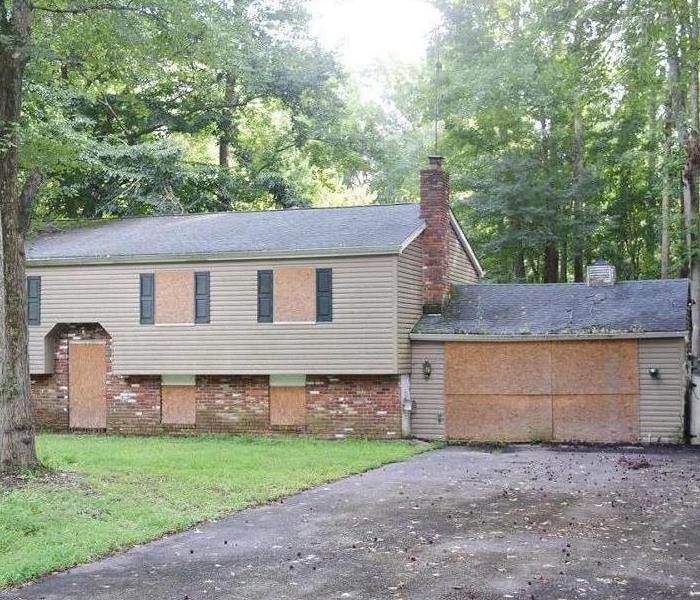 Leave the hassle of board ups to the professionals
Leave the hassle of board ups to the professionals
Have you ever been driving down a road and see those homes all boarded up; you probably think there's nothing to it right, get some plywood, screws and you're all set. However there is actually more to it; first off let's talk about some reasons to board up your property:
- Before or After a Storm
- After a Fire or other Structural Damage
- Maybe it is Vacant or Condemned
These are some of the most common reasons, if you are boarding up your home before a storm consider thickness of plywood or having them custom cut to fit your windows so you don't drill holes into the siding of your home. If extreme storms are common in your area you might consider custom plywood screens that you can keep reusing. If it is after a storm or fire you probably just need the boards up as soon as possible to keep your home secure from vandals.
Whether it is before or after, boarding up damaged property is a burden that no one should ever have to go through. Especially if it is your property that has been damaged. There will be so many other things that need your attention and this should not be one of them. Boarding up damaged property incorrectly could cause secondary damage like animal or moisture intrusion, making the situation worse than it already is. Plus the process of boarding up after unexpected damage can be dangerous in itself if you do not know how to do it. We here at SERVPRO of East Central Morris County can board up the damaged property, mitigate the original damage. We can provide you with the peace of mind while helping make it "Like it never even happened."
If you experience an unexpected damage to your property please give us a call:
SERVPRO of East Central Morris County
(973) 887-9100
Do You Have Dirty Ducts
3/28/2019 (Permalink)
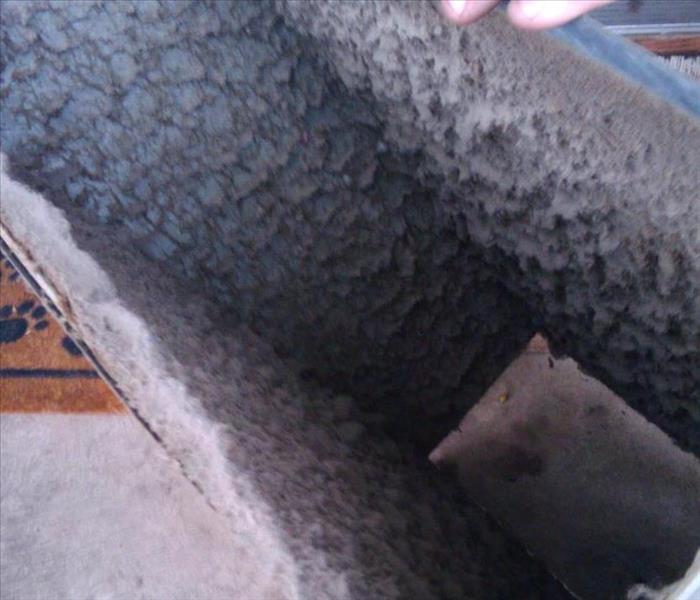 Do you know what's inside your ducts
Do you know what's inside your ducts
Did you know your ventilation system is often the biggest culprit in poor indoor air quality? Inspecting the ductwork in your home/facility should be a high priority. In most cases the HVAC system has been operating for some time without much attention. Dirty Ducts can circulate odors and contaminants through your home or building.
In some circumstances, such as after a fire, smoke or suspected mold growth duct cleaning becomes and essential part of the cleanup process. in most cases we can restore the HVAC system and ductwork to pre-damage condition.
Over time different contaminants or foreign objects can enter and collect in your air ducts that may diminish the indoor air quality of your home or office or cause other damage to your HVAC system; such as
- Rodents
- Insects or Pests
- Dust
- Dirt
- Debris
- Bacteria
- Mold
- Pollen
How we clean your ducts:
- Our process begins by using patented equipment including a roto-scraper which automatically adapts to the duct's shape and diameter while traveling through the duct, removing debris and filth before we start vacuuming.
- Next, a powerful push-pull air delivery and collection system transfers the debris from the ducting to a 16 gallon container
- Air is Filtered through a HEPA filtration system, removing 99.97 percent of the particles in the air stream. HEPA filters capture debris and keep the indoor environment clean.
- System Filters will either be cleaned or replaced to remove the odor and dirt
Make duct cleaning part of your Spring Cleaning routine and it will help with those seasonal allergies.
April Showers Can Bring Home Headaches
3/25/2019 (Permalink)
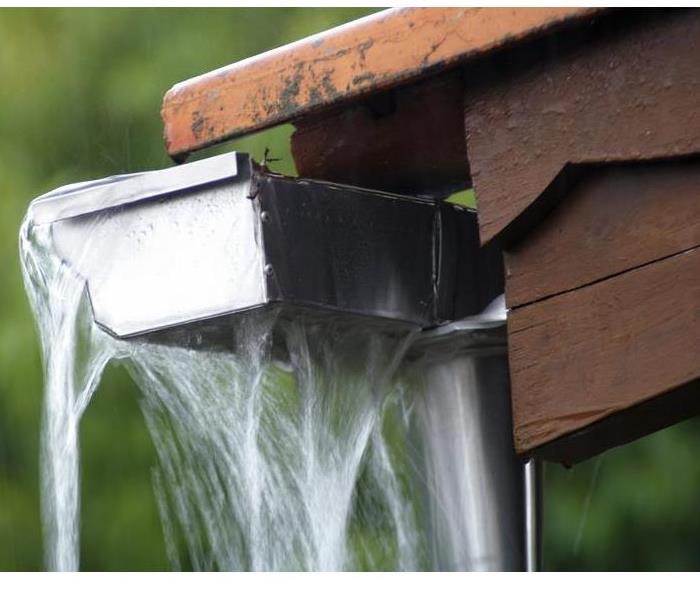 Make sure your rain gutters are clear
Make sure your rain gutters are clear
Did you know that something as simple as clogged gutters can cause major damage in your home. Now that winter is almost over and Spring is coming it is important to check your gutters. With the high winds branches and debris could have filled your gutters you had cleaned just before winter. Cleaning out gutters in the spring might seem like a menial task, but failure to do so can cause major problems for a home. From foundation damage to roof leaks, clogged gutters can lead to expensive repairs when left untreated.
Here are some potential disasters that can happen due to a clogged gutter.
1. In colder climates, ice dams can form on the gutters or the lower edge of the roof, causing water to pool and eventually seep into the home. While ice dams can form on homes with clean gutters, clogged gutters prevent water from draining, which increases the chance for ice dams.
2. The fascia boards that hold the gutter system are often made of wood. When gutters clog and fill with water, the boards start to deteriorate and rot. If a home has wood siding, clogged gutters can also cause water to overflow out of the gutter system and down the sides of the home.
3. The main role of a gutter system is to channel water off the roof and away from the home's foundation. A blockage can cause water to pour over the sides of the gutter and pool around the foundation. Over time, the water can cause cracks to form and damage the foundation, potentially resulting in collapse. But even if the foundation doesn't fail, the water can still cause mold growth.
4. A roof replacement can be expensive and it's important to maximize the value of your current roof. When you let your roof sustain continuous damage every time it rains, the clock is ticking and you greatly diminish its lifespan. Something as simple as cleaning out your rain gutters can help you get the absolute most of your roof and will make sure that you're not having to get costly repairs in the meantime.
National Preparedness Month
9/18/2018 (Permalink)
National Preparedness Month
National Preparedness Month (NPM), recognized each September, provides an opportunity to remind us that we all must prepare ourselves and our families now and throughout the year. This NPM will focus on planning, with an overarching theme: Disasters Happen. Prepare Now. Learn How.
Take time to learn lifesaving skills − such as CPR and first aid, check your insurance policies and coverage for the hazards you may face, such as flood, earthquakes, and tornadoes. Make sure to consider the costs associated with disasters and save for an emergency. Also, know how to take practical safety steps like shutting off water and gas.
The devastating hurricanes and wildfires of 2017 reminded the nation of the importance of preparing for disasters. Often, we will be the first ones in our communities to take action after a disaster strikes and before first responders arrive, so it is important to prepare in advance to help yourself and your community.
2018 Weekly Themes
- Week 1: Sept 1-8 Make and Practice Your Plan
- Week 2: Sept 9-15* Learn Life Saving Skills
- Week 3: Sept 16-22 Check Your Coverage
- Week 4: Sept 23-29 Save For an Emergency
- September 15 is a National Day of Action
Deodorization – Getting Rid of Unpleasant Odors
3/6/2018 (Permalink)
 Hydroxyl
Hydroxyl
Life is full of unpleasant smells. Odors from smoke, pets, decomposition or mold can cause lingering odors in your home or business. A simple surface clean doesn’t necessarily get rid of these smells.
With technicians certified by the Institute of Inspection, Cleaning and Restoration (IICRC), SERVPRO of East Central Morris County provides specialized services that can rid your home or business of offensive odors left by smoke, mold or other sources. Our professionals do not cover up lingering odors with a fragrance; they seek out and remove the sources of the odor. Once the source is found, we use SERVPRO’s own proprietary line of cleaning products to treat and prevent the odor from returning. Any restorable item in affected areas will also be professionally cleaned and deodorized, including furniture, draperies and upholstery, electronics, art, flooring, walls, ceilings, HVAC air ducts, and more.
Along with our proprietary line of cleaning products we use various techniques and equipment to treat odors. These techniques are capable of penetrating surfaces to neutralize an unpleasant odor thoroughly. Some of the tools we use include:
Ozone Generator: The Ozone Generator (shown above) is one of the quickest ways to eliminate odors from a home or office. We use the Ozone Generator to oxidize odor and eliminate odors from mold, mildew, pets, nicotine, smoke and more without the use of chemicals. Though the room being treated cannot be occupied while in use, the generator works quickly to clean, sanitize and remove offensive odors.
Hydroxyl Generator: The Hydroxyl Generator has several benefits that the Ozone Generator does not. The main benefit is that the room being treated can be occupied during the deodorization process; though it does work slower. The Hydroxyl Generator can be used to treat fire and smoke, as well as biohazard jobs, water damage, crime scene situations and animal odors.
Air Filtration Device: This piece of equipment, also known as an air scrubber, is used to remove airborne contaminants during water, fire, smoke, mold and sewage restoration work. These work by pulling air through HEPA filtration to remove airborne particles from the air. This helps clean the air and remove odors.
Whether you are a building manager who needs an apartment cleaned for the next tenant or homeowner who wants to get your home ready for sale, getting rid of offensive odors is a high priority.
Whether it’s fire, water, or mold damage, or just a stubborn odor that refuses to go away, SERVPRO of East Central Morris County is here to help make it “Like it never even happened.” Give us a call at 973-887-9100.
Understanding the risk of carbon monoxide poisoning
11/17/2016 (Permalink)
Each year, unintentional carbon monoxide poisoning claims more than 500 lives and sends another 15,000 people to hospital emergency rooms around the country for treatment. While the temperatures drop, and you and your family turn up the heat in your home and car, remember there are several everyday items that can put you and your family at risk, including gas-fired appliances and wood-burning fireplaces.
Preventative Measures
Consider installing at least one carbon monoxide alarm with an audible warning signal. Follow these tips when installing a Carbon Monoxide detector in your home:
• Install it in a location that it can easily be seen and heard.
• Put it near bedrooms, the living room, main hallways or where you and your family spend a significant amount of time.
Do not put a Carbon Monoxide detector in the following locations:
• In the garage.
• Near your furnace or kitchen stove.
• In excessively hot, cold, damp, or dry areas.
• In the corner of a room, near the floor, in the peak of vaulted ceilings, or near open windows or doors.
Since CO alarms measure CO levels over time, the alarm will sound before an average, healthy adult would be experiencing symptoms. If you are not experiencing symptoms when the alarm sounds, please consider ventilating the home and contacting a service professional to check the CO level.
If you are experiencing symptoms of CO poisoning, experts say to evacuate immediately and contact emergency personnel. And, of course, never run your vehicle inside your garage with the door closed. Even with doors open, refrain from running your vehicle for extended periods of time, as garages with a door on only one side often do not provide adequate air flow.
If you have any questions or concerns regarding safety and preparedness in your business or home, give us a call at 973-887-9100.
Back To School Home Safety
8/30/2016 (Permalink)
As we are nearing the end of August, and parents are enjoying their last few days before school we can only think of the many safety tips that parents should consider around the house.
In the Kitchen:
-Are knives, forks, scissors, and other sharp tools in a drawer with a childproof latch?
-Are glass objects and appliances with sharp blades stored out of reach?
-Are matches and lighters stored in a locked cabinet
In Bedrooms:
-Are window blind and curtain cords tied with clothespins or specially designed cord clips?
-Is there a smoke alarm outside the bedroom?
In Bathrooms:
-Are razor blades, nail scissors, and other sharp tools stored in a locked cabinet?
-Are all medication bottles, loose pills, coins, scissors, and any other small or sharp objects out of reach?
- Are all bleaches, detergents, and any other cleaning products out of reach?
Electrical:
-Have you checked for and removed other potential electrical fire hazards, such as overloaded electrical sockets and electrical wires running under carpets?
-Are all unused outlets covered with safety plugs?
Excessive Heat Warning
7/20/2016 (Permalink)
Excessive Heat Warning
The National Weather Service has issued an Excessive Heat Warning, in effect until 7pm Saturday.
Temperatures near 100 with heat index of 110 degrees can be expected daily.
An Excessive Heat Warning means that a prolonged period of dangerously hot temp and high humidity will occur. In addition, nighttime conditions will remain warm and muggy, providing little relief. This combination will create a dangerous situation in which heat-related illnesses are likely. Especially for those living in un-air conditioned homes or apartments. People are advised to avoid poorly ventilated areas and prolonged work in the sun.
Remember to hydrate hydrate hydrate...
Emergency Supply Kit
4/26/2016 (Permalink)
Severe weather can happen any time, anywhere. Each year, Americans cope with an average of the following intense storms*:
10,000 severe thunderstorms
5,000 fl oods or fl ash floods
1,000 tornadoes
2 landfalling deadly hurricanes
Approximately 98 percent of all presidentially declared disasters are weather-related, leading to around 500 deaths per year and nearly $15 billion in damage.*
Knowing your risk of severe weather, taking action and being an example are just a few steps you can take to be better prepared to save your life and assist in saving the lives of others.
Know Your Risk. The first step to becoming weather-ready is to understand the type of hazardous weather that can aff ect where you live and work, and how the weather could impact you, your business and your family. Check the weather forecast regularly, obtain a NOAA Weather Radio, and learn about Wireless Emergency Alerts. Severe weather comes in many forms and your shelter plan should include all types of local hazards.
Take Action. Take the next step in severe weather preparedness by creating a communications plan for your home and business. Put together or purchase an emergency kit. Keep important papers and valuables in a safe place. Be an Example. Once you have taken action to prepare for severe weather, share your story with co-workers and family and friends on Facebook or Twitter. Your preparedness story will inspire others to do the same.
Water (one gallon per person per day)
Food (non-perishable 3-day supply)
Manual can opener
Battery operated radio, preferably a NOAA Weather Radio
Flashlight and extra batteries
First aid kit
Whistle to signal for help
Clothing
Dust masks or bandanas
Plastic sheeting, garbage bags and duct tape
Wrench or pliers to turn off utilities
Hygiene items
Important documents; copies of insurance policies, identification and bank account information
Cash
Fire extinguisher
Matches in a waterproof container
Spring cleaning
4/11/2016 (Permalink)
***MARK YOUR CALENDARS***
The National Prescription Drug Take-Back Day aims to provide a safe, convenient, and responsible means of disposing of prescription drugs, while also educating the general public about the potential for abuse of medications.
WHERE: Stop & Shop Supermarket, 245 Littleton Road, Morris Plains, NJ 07950.
WHEN: April 30th, 2016
TIME: 10:00 A.M. TILL 2 P.M.
All Prescription and Non-Prescription medications accepted.
Happy Holidays
12/14/2015 (Permalink)
SERVPRO of East Central Morris County would like to wish all of our friends and family a very safe and happy holiday season!
It's National Preparedness Month
9/4/2015 (Permalink)
SERVPRO Press Release
SERVPRO® Wants People to Be Prepared
It's National Preparedness Month and a restoration service company is offering tips for expecting the unexpected
Morris Plains NJ (August 26, 2009) -- SERVPRO is proud to be participating in the sixth annual National Preparedness Month (NPM) in September. Sponsored by the Ready Campaign, NPM is a nationwide effort designed to increase awareness as well as encourage individuals, families businesses and communities to take action and prepare for emergencies.
With that in mind, SERVPRO wants to help people be ready in the event of a natural or man-made disaster. The restoration service is joining with the U.S. Department of Homeland Security to recognize National Preparedness Month.
"Natural disasters take many forms, and while they may be inevitable, they don't always have to be devastating," said Rick Isaacson, executive vice president of SERVPRO Industries, Inc. "By taking action now, people can potentially lessen the impact they experience from catastrophes. Being prepared is the best defense one can have."
According to the Federal Emergency Management Agency (FEMA), there were 75 declared disasters in 2008, which was a 19 percent increase from those reported in 2007. So far, in 2009, the Agency has recorded 42, and the number is expected to rise as hurricane season approaches the southeast.
"Whether it's with a tornado, torrential rains or heavy snow, Mother Nature can wreak havoc at all times of the year, and oftentimes, the events can come without warning," said Isaacson. "That is why we are urging people to designate National Preparedness Month as a time to sit down with their families and make a plan."
Isaacson says that the following three action steps can help families prepare for the worse:
- Create an Emergency Supply Kit – Start by thinking about the basics for survival – fresh water, food, clean air and warmth. In addition, be sure to include a battery-powered radio (with extra batteries), flashlight, first aid kit, a can opener to open canned food, and a cell phone with chargers.
- Make a Family Emergency Plan – Your family may not all be together when a disaster strikes, so it is critical to establish an out-of-town contact to facilitate communication. Also, when using cell phones, know that text messages can often get around network disruptions when a phone call might not be able to get through.
- Be Informed – Visit your state and local government Web sites to learn about the particular emergency plans that have been established in your area. You can also download tools to better prepare your family for a disaster at www.ready.gov.
"National Preparedness Month serves as a good reminder that we all have a responsibility in protecting ourselves, our employees, our families and our communities," said Isaacson. "Emergencies will happen, but taking action now can help us minimize the impact they will have on our lives."
Isaacson goes on to add that even if a family has an emergency preparedness plan in place, this month is an ideal time to update it and make sure that all members of the family are familiar with its contents. In addition, individuals would be wise to make sure that a similar plan is in place at work.
In the event of fire or water damage caused by a natural disaster, SERVPRO offers an assortment of services to help people quickly recover and restore any damaged property. Within four hours of the initial notification, a SERVPRO Franchise Professional will be on-site to start the mitigation process. Exceptions may apply under certain conditions, such as a catastrophic event or a storm situation.
For more information on SERVPRO, please visit www.SERVPRO.com or call SERVPRO of East Central Morris County at 973-887-9100. You can also visit http://www.SERVPROeastcentralmorriscounty.com/ to learn about your local franchise.
About SERVPRO
Founded in 1967, the SERVPRO franchise system is a national leader and provider of fire and water cleanup and restoration services and mold mitigation and remediation. SERVPRO's professional services network of more than 1,400 individually owned and operated franchises responds to property damage emergencies ranging from small individual disasters to multi-million dollar large-loss situations. Providing coverage in 48 states, the SERVPRO System has established relationships with major insurance companies and commercial clients, as well as individual homeowners. All SERVPRO franchises are independently owned and operated.
Continuing Education
4/25/2014 (Permalink)
We have new course offering in our Continuing education series:
‘Biohazards and Bio-Recovery for Property Insurers’
Course Date: May 6, 2014
The course is offered free of charge to insurance agents, property managers, adjusters, and other interested parties.
Attached is information regarding the location and course content.
Please call our office if you or your associates would like to attend and if so how many will be attending.
Best wishes.
Note: While not overly graphic, this course contains images of hoarding, human blood; human and animal waste; infected body parts; and crime scenes. If you are sensitive to these types of images or subject matter, please do not sign up for this course!




 24/7 Emergency Service
24/7 Emergency Service






